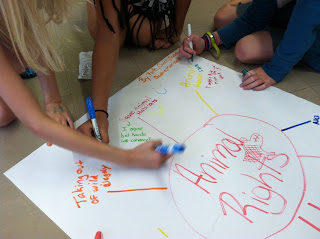On a side note, you can find more of the information about how to go about teaching a theme unit on empathy in an article Holly Mueller and I wrote for Choice Literacy. If you're not currently a member of Choice Literacy, I highly recommend joining. For less than $100 a year, you can find a wealth of ideas and information about teaching ELA in any grade level. If you just want a sneak peek, you can sign up for the weekly newsletter, The Big Fresh, and have access to several free articles a week.
I started the year by reading several picture books that dealt with bullying and simple examples of how being empathetic to someone could have helped that person out. We also talked a lot about characters that show lack of empathy. Here are some of the titles I shared with my 5th graders:
All these books provided students with concrete examples of what empathy and lack of empathy looked like and sounded like. As we read Each Kindness, we even collected sentences that showed empathy or lack thereof by marking specific lines with post-it notes.
Once I was convinced my students had a decent understanding of empathy, we moved on to our first read-aloud, the Newbery Award winner, The One and Only Ivan by Katherine Applegate.
If you haven't read this book, you MUST! Take a look at the book trailer below. You'll be sold!
We're over half way through Ivan and we've been talking not only about empathy, but also how empathy and animal rights are connected. We read another story of animal rescue by Kriby Larson and Mary Nethery, called The Two Bobbies.
This is a sweet story of a dog and cat that save each other in the aftermath of Hurricane Katrina. We talked about the rights animals have (or should have). We tied that into The One and Only Ivan and we had a classroom full of opinions about rights that all animals should be entitled to. These strong feelings naturally led to some contemplation and writing.
Here's what we did:
1. I put the kids into groups and they had to come up with 3-5 rights they felt all animals should have. This was easy for some groups, but hard for others that were less likely to compromise with each other. Another lesson in empathy there.
2. After the groups came up with their 3-5 rights, they put it on chart paper in whatever format they wished to use.
3. Each child took a marker with them and responded to each group's poster of animal rights. We had a big discussion about how a comment like, "I agree" doesn't go deep enough. They listened! Check out some of the charts below:
4. After responding to others' charts, each student chose a right they felt strongly about and made a claim, backed up by evidence (in this case, their opinions). Here are a couple of examples:
These did a great job of making the connection between animal rights and empathy. We've had a lot of discussion about how to treat others and animals. Next week, we're moving on to a discussion of empathy and human rights. On the docket to share is this great kid-friendly video about the origin of human rights. Then, we'll share some more picture books to discuss empathy or lack of it and how it affected human rights or lack thereof. Some of the books I'm looking forward to sharing next week are:
I'm also looking forward to finishing The One and Only Ivan and starting a new read-aloud, Wonder by R.J. Polacio.
This book is rife with opportunities to feel empathetic. It's also a great launching point to discuss what how people should be treated. Added bonus? It's about fifth graders!
Empathy is such an important theme in our class throughout the year. It's a great launching point in September to set the stage for the rest of the year.



























